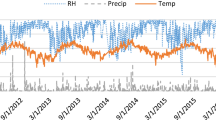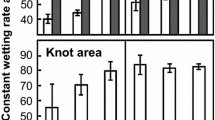Summaries
Exterior coatings may not provide sufficient protection of wood against biodeterioration. In order to minimise the decay risk, wood can be impregnated with biocides before finishing. However, pretreatment of wood may have an effect on some important properties of surface coatings. The authors impregnated spruce wood specimens with a new preservative formulation, containing the ester of boric acid with an alkanolamine. The aim of this research was to establish a possible influence of this biocide on the performance of acrylic and alkyd stains on pre-treated wood. They studied the drying characteristics, stackability, adhesion, and permeability of the coatings. A boron-based preservative in a treated spruce wood had a pronounced influence on the drying of coatings and on the permeability of the acrylic stain. However, the influence on adhesion of the coatings was only indicated.
Résumé
Il se peut que les revêtements extérieurs ne fournissent pas au bois une protection adéquate contre la biodégradation. Pour minimaliser le risque de la pourriture le bois peut être imprégné de biocides avant la finition. Cependant le prétraitement du bois pourrait avoir des effets sur quelques propriétés importantes des revêtements de surface. Les auteurs ont imprégné des échantillons d’épinette d’une nouvelle formulation préservatrice qui contient l’ester de l’acide borique et une alkanolamine. Le but de cette étude était d’établir l’existence d’une influence éventuelle de ce biocide sur la performance des teintures acryliques et alkydiques sur du bois prétraité. Les auteurs ont étudié les caractéristiques du séchage, la gerbabilité, l’adhésion et la perméabilité des revêtements. Un agent de conservation à base de bore introduit dans un échantillon d’épinette traité avait une influence prononcée sur le séchage des revêtements et sur la perméabilité de la teinture acrylique. Cependant l’influence sur l’adhésion des revêtements était indiquée seulement.
Zusammenfassung
Holzanstriche allein sind nicht immer ein ausreichender Schutz vor Verfall durch biologische Einflüsse. Um das Verfallsrisiko zu minimisieren ist es möglich, Holz mit Bioziden vorzubehandeln. Allerdings kann diese Vorbehandlung einen Einfluß auf die Eigenschaften der Anstriche haben. Die Autoren dieser Arbeit behandelten Fichtenholz mit einer neuen Konservierungsmittelformulation, die einen Borsäureester und ein Alkanolamin enthielt. Das Ziel dieser Arbeit war, einen möglichen Einfluß dieses Biozides auf die Leistung von Acryl- und Alkylanstrichen zu untersuchen. Wir fanden, daß ein Borsäurehaltiges Konservierungsmittel einen deutlichen Einfluß auf die Trockenzeit beider Anstriche und die Durchlässigkeit des Acrylanstriches hatte. Ein Einfluß auf die Adhäsionskraft der Anstriche war nur schwach bemerkbar.
Similar content being viewed by others
References
Arnold M, ‘Moisture content of wood painted with low VOC coatings during outdoor exposure test’, Proceedings of Surface Properties and Durability of Exterior Wood Building Components international conference, Paper 7, (ed) H Turkulin, Faculty of Forestry, Zagreb, 1999
Graystone J, ‘Moisture transport through wood coatings: The unanswered question’, Proceedings of Advances in Exterior Wood Coatings and CEN Standardisation Conference, Paper 6, Brussels, 1998
Rapp A O and R D Peek, ‘Melaminharzimprägniertes sowie mit Wetterschutzlasur oberflächenbehandeltes und unbehandelets Vollholz während zweijähriger Freilandbewitterung’,Holz als Rohund Werkstoff,57, 331–9, 1999
Despot R, J Trajkovic and T Sinkovic, ‘The influence of type and colour of coat on the durability of exterior fir wood joinery’, Proceedings of Surface Properties and Durability of Exterior Wood Building Components international conference, Paper 8, (ed) H Turkulin, Faculty of Forestry, Zagreb, 1999
Plackett D V and F M Cameron, ‘The performance of water repellents on radiata pine exposed to the weather’, The International Research Group on Wood Preservation, Document No IRG/WP 3553, 1989
Evans P D, A J Michell and K J Schmalzl, ‘Studies of the degradation and protection of wood surfaces’,Wood Science and Technology,26, 151–63, 1992
Cui F and K Archer, ‘Treatment of lumber with preservative/water repellent emulsions — the significance of shear stability on penetration’, The International Research Group on Wood Preservation, Document No IRG/WP 97-20124, 1997
Plackett D V, E A Dunningham and A P Singh, ‘Weathering of chemically modified wood: Accelerated weathering of acetylated radiata pine’,Holz als Roh- und Werkstoff,50, 135–40, 1992
Militz H, E P J Beckers and W J Homan, ‘Modification of solid wood: Research and practical potential’, The International Research Group on Wood Preservation, Document No IRG/WP 97-40098, 1997
Yalinkilic M K, R Ilhan, Y Imamura, M Takahashi, Z Demirci, A C Yalinkilic and H Peker, ‘Weathering durability of CCB-impregnated wood for clear varnish coatings’,Journal of Wood Science,45, 502–14, 1999
Lloyd J D, ‘Borates and their biological applications’, The International Research Group on Wood Preservation, Document No IRG/WP 98-30178, 1998
Schoeman M W and J D Lloyd, ‘The role of boron-based additives in exterior wood coatings’,Surface Coatings International,82, 124–7, 1999
Peylo A and H Willeitner, ‘Bewertung von Boraten als Holzschutzmittel’,Holz als Roh- und Werkstoff,58, 476–482, 2001.
Dinwoodie J M,Timber: Its Nature and Behaviour, (2nd edition), 221–49, E & FN Spon, London and New York, 2000
Peylo A and H Willeitner, ‘The problem of reducing the leachability of boron by water repellents’,Holzforschung,49, 211–6, 1995
Homan W J and H Militz, ‘Influence of a surface coating on the leachability of boric acid and bifluorides from spruce wood’, The International Research Group on Wood Preservation, Document No IRG/WP 95-50050, 1995
Peylo A and W Willeitner, ‘Leaching of boron — more than three years of field exposure’, The International Research Group on Wood Preservation, Document No IRG/WP 97-30143, 1997
Morris P I, ‘Ten year performance of L-joints made from borate diffusion treated wood’, The International Research Group on Wood Preservation, Document No IRG/WP 00-30225, 2000
Petric M, F Pohleven, T Okorn and F Cadez, ‘Efficacy of some boron containing wood preservatives’, Proceedings of Wood in Construction Industry international conference, (ed) R Despot, Faculty of Forestry, Zagreb, 2000
Petric M, M Pavlic, D Berglez, B Kricej and F Cadez, ‘Compatibility of impregnated construction wood with surface coatings’, Proceedings of Wood in Construction Industry international conference’, (ed) R Despot, Faculty of Forestry, Zagreb, 2000
Ra JB, H M Barnes and T E Conners, ‘Determination of boron diffusion coefficients in wood’,Wood and Fiber Science,33, (1), 90–103, 2001
DIN 53 150, ‘Prüfung von Anstrichstoffen und ähnlichen Beschichtungsstoffen — Bestimmung des Trockengrades von Anstrichen (Abgewandeltes Bandow-Wolf-Verfahren)’, 1971
EN ISO 4622, ‘Paints and varnishes — Pressure test for stackability (ISO 4622:1992)’, 1994
EN ISO 2808, ‘Paints and varnishes — Determination of film thickness (ISO 2808:1997)’, 1999
EN 24624, ‘Paints and varnishes — Pull-off test (ISO 4624:1978)’, 1997
EN 927-5, ‘Paints and varnishes — Coating materials and coating systems for exterior wood. Part 5: Assessment of the liquid water permeability’, 2000
Ahola P, H Derbyshire, G Hora and M de Meijer, ‘Water protection of wooden window joinery painted with low organic solvent content paints with known composition’,Holz als Roh- und Werkstoff,57, 45–50, 1999
de Meijer M, ‘Interactions between wood and coatings with low organic solvent content’, PhD thesis, Wageningen University, Wageningen, 1999
Ekstedt J and G Östberg, ‘Liquid water permeability of exterior wood coatings — Testing according to a proposed European standard method’,Journal of Coating Technology,73, (914), 53–9, 2001
Kotama L, ‘Surface coatings for impregnated wood’, The International Research Group on Wood Preservation, Document No IRG/WP 3684-92, 1992
Feist W C and A S Ross, ‘Performance and durability of finishes on previously coated CCA-treated wood’,Forest Products Journal,45, 29–36, 1995
Yalinkilic M K, Y Imamura, M Takahashi, R Ilhan, A C Yalinkilic and Z Demirci, ‘FTIR studies of outdoor exposure on varnish-coated wood pretreated with CCB on water repellent’,Journal of Coatings Technology,71, 103–12, 1999
Bardage S L and J Bjurman, ‘Adhesion of Waterborne Paints to Wood’,Journal of Coating Technology,70, (878), 39–47, 1998.
Sonoda A, N Takagi, K Ooi and T Hirotsu, ‘Complex Formation between Boric Acid and Triethanolamine in Aqueous Solutio’,Bulletin of the Chemical Society of Japan,71, (1), 161–6, 1998
Author information
Authors and Affiliations
Corresponding author
Rights and permissions
About this article
Cite this article
Pavlic, M., Kricej, B., Tomazic, M. et al. Influence of biocide pre-treatment of wood on performance of exterior coatings. Surface Coatings International Part B: Coatings Transactions 88, 41–48 (2005). https://doi.org/10.1007/BF02699706
Issue Date:
DOI: https://doi.org/10.1007/BF02699706




